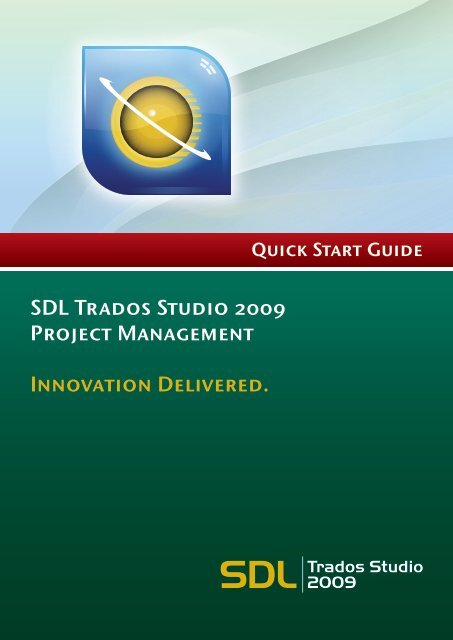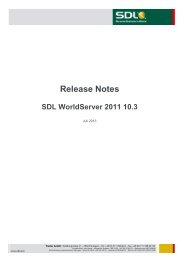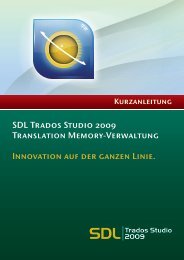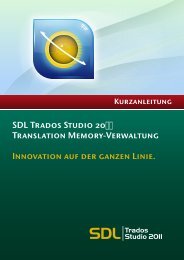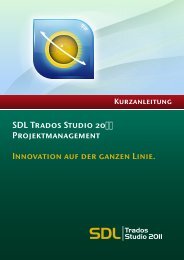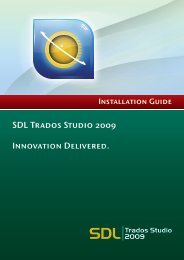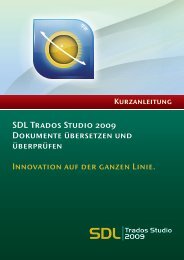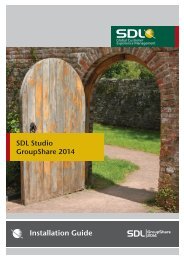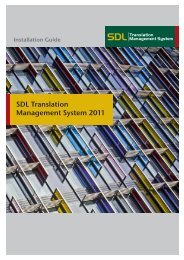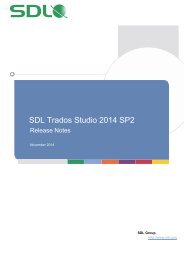SDL Trados Studio Project Management Quick Start ... - Tradosy.cz
SDL Trados Studio Project Management Quick Start ... - Tradosy.cz
SDL Trados Studio Project Management Quick Start ... - Tradosy.cz
You also want an ePaper? Increase the reach of your titles
YUMPU automatically turns print PDFs into web optimized ePapers that Google loves.
<strong>Quick</strong> <strong>Start</strong> Guide<br />
<strong>SDL</strong> <strong>Trados</strong> <strong>Studio</strong> 2009<br />
<strong>Project</strong> <strong>Management</strong><br />
Innovation Delivered.
COPYRIGHT<br />
<strong>SDL</strong> <strong>Trados</strong> <strong>Studio</strong> <strong>Project</strong> <strong>Management</strong> <strong>Quick</strong> <strong>Start</strong> Guide<br />
Copyright ©2009-2010 <strong>SDL</strong> plc.<br />
All rights reserved. No part of this documentation may be duplicated in whole or in<br />
part or reproduced in any form without the express written permission of <strong>SDL</strong> plc.<br />
This product may include open source or similar software designated: Hunspell<br />
distributed under GNU Lesser General Public License version 3; Sharpziplib and<br />
Spring.net distributed under GNU General Public License version 3 with restrictions;<br />
ICU distributed under IBM ICU License; Log4Net, Xalan and Xerces distributed under<br />
Apache License version 2.0; Wix distributed under Common Public License version1.0;<br />
and SQLite which is public domain and requires no license for this distribution.<br />
<strong>Trados</strong>, MultiTerm, <strong>SDL</strong> PerfectMatch, <strong>SDL</strong>X, Passolo and TranslationZone are<br />
registered trademarks of <strong>SDL</strong> plc. Translator's Workbench, <strong>Trados</strong> <strong>Studio</strong>, TagEditor,<br />
<strong>Quick</strong>Place and AutoSuggest are trademarks of <strong>SDL</strong> plc. All other trademarks are the<br />
property of their respective owners. The names of other companies and products<br />
mentioned herein may be the trademarks of their respective owners. Unless stated to<br />
the contrary, no association with any other company or product is intended or should<br />
be inferred.<br />
Although <strong>SDL</strong> takes all reasonable measures to provide accurate and comprehensive<br />
information about the product, this documentation is provided as-is and all warranties,<br />
conditions or other terms concerning the documentation whether express or implied<br />
by statute, common law or otherwise (including those relating to satisfactory quality<br />
and fitness for purposes) are excluded to the extent permitted by law.<br />
Information in this documentation, including any URL and other Internet Web site<br />
references, is subject to change without notice. Without limiting the rights under<br />
copyright, no part of this document may be reproduced, stored in or introduced into a<br />
retrieval system, or transmitted in any form or by any means (electronic, mechanical,<br />
photocopying, recording, or otherwise), or for any purpose, without the express<br />
written permission of <strong>SDL</strong> plc.<br />
This guide ships with <strong>SDL</strong> <strong>Trados</strong> <strong>Studio</strong> 2009.<br />
August 2010<br />
<strong>Project</strong> <strong>Management</strong> <strong>Quick</strong> <strong>Start</strong> Guide<br />
Page 2
Table of Contents<br />
COPYRIGHT ................................................................................................................. 2<br />
Table of Contents ........................................................................................................ 3<br />
About this <strong>Quick</strong> <strong>Start</strong> Guide ...................................................................................... 4<br />
Who is This Guide For ..................................................................................................................... 4<br />
How to Use this Guide ..................................................................................................................... 4<br />
Other Information Sources ............................................................................................................... 4<br />
About <strong>SDL</strong> <strong>Trados</strong> <strong>Studio</strong> ............................................................................................ 5<br />
Description ...................................................................................................................................... 5<br />
The Views ........................................................................................................................................ 5<br />
<strong>Project</strong> Workflow with <strong>Project</strong> Packages ........................................................................................... 7<br />
Default Language Pair Settings .................................................................................. 8<br />
Language Pairs ................................................................................................................................ 8<br />
Options Dialog Box .......................................................................................................................... 8<br />
Resources ....................................................................................................................................... 10<br />
How to Define your Default Language Pair Settings ....................................................................... 11<br />
<strong>Project</strong> Concepts ....................................................................................................... 14<br />
Creating <strong>Project</strong>s ...................................................................................................... 15<br />
How to Create a <strong>Project</strong> ................................................................................................................. 15<br />
Active <strong>Project</strong> ............................................................................................................................................................. 22<br />
Translation File Status ................................................................................................................................................ 22<br />
Working with Packages ............................................................................................ 23<br />
<strong>Project</strong> Package ............................................................................................................................. 23<br />
Return Package .............................................................................................................................. 23<br />
Recommended Package Use........................................................................................................... 23<br />
How to Create a Package ............................................................................................................... 24<br />
How to Open a Return Package ..................................................................................................... 28<br />
Tracking <strong>Project</strong> Status ............................................................................................. 29<br />
Generating a Report ...................................................................................................................... 29<br />
Finalizing your <strong>Project</strong> Files ...................................................................................... 31<br />
How to Finalize your <strong>Project</strong> Files ................................................................................................... 31<br />
End of <strong>Quick</strong> <strong>Start</strong> Guide ........................................................................................... 33<br />
<strong>Project</strong> <strong>Management</strong> <strong>Quick</strong> <strong>Start</strong> Guide<br />
Page 3
About this <strong>Quick</strong> <strong>Start</strong> Guide<br />
Who is This Guide For<br />
This guide is for project managers. It focuses on the project lifecycle, starting with<br />
creating a project and then managing that project through the use of packages.<br />
How to Use this Guide<br />
You can use the sample files to complete the exercises. Each exercise builds on the last so<br />
if you are using the sample files you need to follow through the instructions step-bystep.<br />
This symbol indicates there are sample files available to complete the<br />
exercise and their location.<br />
Tip<br />
This symbol indicates that there is tip providing additional information on<br />
the task you are performing.<br />
NOTE<br />
This symbol indicates that there is an important piece of information you<br />
need to know for the task you are performing.<br />
Keyboard<br />
Shortcuts<br />
Any keys that you need to press on your keyboard are displayed in the<br />
following font: Ctrl+Enter.<br />
Other Information Sources<br />
Here are some other sources of information you can access:<br />
<strong>SDL</strong> <strong>Trados</strong> <strong>Studio</strong> Help<br />
<strong>SDL</strong> TM Server Help<br />
<strong>SDL</strong> Server Installation Guide<br />
<strong>SDL</strong> <strong>Trados</strong> <strong>Studio</strong> Migration Guide<br />
Translating and Reviewing Documents <strong>Quick</strong> <strong>Start</strong> Guide<br />
Translation Memory <strong>Management</strong> <strong>Quick</strong> <strong>Start</strong> Guide<br />
<strong>Project</strong> <strong>Management</strong> <strong>Quick</strong> <strong>Start</strong> Guide<br />
Page 4
About <strong>SDL</strong> <strong>Trados</strong> <strong>Studio</strong><br />
Description<br />
<strong>SDL</strong> <strong>Trados</strong> <strong>Studio</strong> enables organizations to effectively manage all aspects of translation<br />
projects. <strong>SDL</strong> <strong>Trados</strong> <strong>Studio</strong> incorporates project management and computer-aided<br />
translation (CAT) tools for use by project managers, translators, editors, proofreaders<br />
and other language professionals. These are presented in easy-to-use views which you<br />
can arrange to look and work the way that you prefer.<br />
The Views<br />
To display a view in <strong>SDL</strong> <strong>Trados</strong> <strong>Studio</strong>, click the button that bears the name of the view<br />
or the icon for that view. The view navigation buttons appear at the bottom of the<br />
navigation pane.<br />
<strong>Project</strong> <strong>Management</strong> <strong>Quick</strong> <strong>Start</strong> Guide<br />
Page 5
View<br />
Home<br />
Description<br />
The following are some of the commands you can<br />
access:<br />
<br />
<br />
<br />
<br />
<br />
<br />
<br />
<br />
Create a new project.<br />
Open packages.<br />
Create or open translation memories.<br />
Define default global settings.<br />
Open <strong>SDL</strong> MultiTerm where you can create and<br />
maintain your termbases.<br />
Upgrade translation memories.<br />
Localize software in <strong>SDL</strong> Passolo Essential.<br />
Align translated documents in <strong>SDL</strong> WinAlign.<br />
Selecting any of these commands will switch you to<br />
the appropriate view in <strong>SDL</strong> <strong>Trados</strong> <strong>Studio</strong> or open<br />
another application where you can perform the<br />
action.<br />
<strong>Project</strong>s<br />
This is where you view and work with projects. You<br />
can select a project to view detailed project and file<br />
information and track project and file status.<br />
This is where you work with project files. From here<br />
you can:<br />
Files<br />
<br />
<br />
<br />
<br />
Open files for translation.<br />
Open files for review.<br />
Perform batch processing on files.<br />
You can also view word counts and translation<br />
progress for these files.<br />
Reports<br />
This is where you view project reports. The reports<br />
provide detailed translation analysis figures which<br />
feed directly into the project planning and<br />
budgeting process.<br />
Editor<br />
This is where documents are translated and<br />
reviewed.<br />
Translation Memories<br />
This is where you create and manage translation<br />
memories.<br />
<strong>Project</strong> <strong>Management</strong> <strong>Quick</strong> <strong>Start</strong> Guide<br />
Page 6
<strong>Project</strong> Workflow with <strong>Project</strong> Packages<br />
<strong>SDL</strong> <strong>Trados</strong> <strong>Studio</strong> allows you to use the workflow that suits your needs. The following<br />
diagram shows a typical workflow if you are working with projects and packages in <strong>SDL</strong><br />
<strong>Trados</strong> <strong>Studio</strong>.<br />
NOTE For more information about other workflows, see the <strong>SDL</strong> <strong>Trados</strong> <strong>Studio</strong><br />
Help.<br />
<strong>Project</strong> <strong>Management</strong> <strong>Quick</strong> <strong>Start</strong> Guide<br />
Page 7
Default Language Pair Settings<br />
Language Pairs<br />
A language pair is used to store settings relating to translation from a specific source<br />
language into a specific target language. Resources and options are typically configured<br />
for use across all language pairs to which they apply. Multilingual resources, such as<br />
termbases and server-based translation memories, may apply to more than one<br />
language pair. Bilingual resources, such as file-based translation memories, only apply to<br />
a specific language pair.<br />
You may want to set up your default settings for a language pair prior to translating<br />
documents or creating projects. This allows you to use the same settings and resources<br />
for all your translation projects for that language pair.<br />
For example, if you always have translation projects that are translated from English to<br />
German, you may want to specify which translation memory, termbase and other<br />
resources to use.<br />
Options Dialog Box<br />
You can define default settings for use in your translation projects in the Options dialog<br />
box. When you define settings here, it automatically updates the default project<br />
template which you can then select when creating your project. The default project<br />
template is stored in:<br />
…My Documents\<strong>SDL</strong> <strong>Trados</strong> <strong>Studio</strong>\<strong>Project</strong>s\Samples\<strong>Project</strong><br />
Templates\Default.sdltpl<br />
Tip<br />
Alternatively, you can also use project templates to define your settings for<br />
different customers for which you need to create several projects. Select<br />
<strong>Project</strong> > Create <strong>Project</strong> Template from the menu bar to create a<br />
template.<br />
<strong>Project</strong> <strong>Management</strong> <strong>Quick</strong> <strong>Start</strong> Guide<br />
Page 8
All Language Pairs<br />
Typically, you configure translation resources (even if they are bilingual) and edit<br />
settings at the All Language Pairs level. The settings then apply to all language pairs<br />
and the translation resources apply to the all language pairs to which they are relevant.<br />
For example:<br />
<br />
<br />
If you select a multilingual server-based translation memory at the All Language<br />
Pairs level that contains English to German and English to French language pairs, this<br />
translation memory is automatically selected for English to German and English to<br />
French projects.<br />
If you change the minimum match value to 65% at the All Language Pairs level, it<br />
will apply to all language pairs.<br />
Tip<br />
Individual exceptions to these settings can be defined for each language pair.<br />
For example, if you wanted the English to German language pair to have a<br />
different minimum match value, you could change it at the individual<br />
language pair level.<br />
All Language<br />
Pairs<br />
Individual<br />
Language<br />
Pairs<br />
<strong>Project</strong> <strong>Management</strong> <strong>Quick</strong> <strong>Start</strong> Guide<br />
Page 9
Resources<br />
You can select the following resources for a language pair:<br />
Resource<br />
Translation<br />
Memories<br />
Description<br />
The <strong>SDL</strong> <strong>Trados</strong> <strong>Studio</strong> translation memory format is .sdltm. If you have<br />
a translation memory from a previous version of <strong>SDL</strong> <strong>Trados</strong> or <strong>SDL</strong>X,<br />
refer to the online help or the <strong>SDL</strong> <strong>Trados</strong> <strong>Studio</strong> 2009 Migration Guide<br />
for details of how to upgrade the translation memory to the current<br />
format.<br />
You can also connect to server-based translation memories.<br />
Automated<br />
Translation<br />
Server<br />
Automated translation is translation performed by computer software<br />
without human interaction. The application that provides the<br />
automated translation is installed on a server and is accessed in a<br />
similar way to a server-based translation memory. <strong>SDL</strong> offers a default<br />
Automated Translation Server for selection or you can add your own.<br />
<strong>SDL</strong> MultiTerm 2009 (.sdltb) termbases are used in <strong>SDL</strong> <strong>Trados</strong> <strong>Studio</strong><br />
2009. In addition, you can use the following legacy termbase formats.<br />
Termbases<br />
<br />
<br />
<strong>SDL</strong> MultiTerm 2007 (version 7.5) and previous 7.x releases<br />
<strong>SDL</strong> MultiTerm iX (version 6.x).<br />
When you open legacy termbases, they are automatically upgraded to<br />
<strong>SDL</strong> MultiTerm 2009 (.sdltb) format.<br />
You can also connect to sever-based termbases.<br />
AutoSuggest editing is an important new feature which can be used to<br />
speed up manual translation. AutoSuggest monitors what you are<br />
typing and, after you have typed the first few characters of a word,<br />
presents you with a list of suggested words and phrases from the<br />
translation memory in the target language that start with the same<br />
characters. You can use the following as sources for AutoSuggest:<br />
AutoSuggest<br />
Dictionaries<br />
<br />
<br />
<br />
AutoSuggest dictionaries - create a new or select an existing<br />
AutoSuggest dictionary created by yourself or another user. This<br />
dictionary contains words and phrases extracted from translation<br />
memories (.sdltm) or .tmx files.<br />
An <strong>SDL</strong> MultiTerm termbase selected in your project.<br />
AutoText entries - create a list of words and phrases manually by<br />
typing them into <strong>SDL</strong> <strong>Trados</strong> <strong>Studio</strong>.<br />
<strong>Project</strong> <strong>Management</strong> <strong>Quick</strong> <strong>Start</strong> Guide<br />
Page 10
How to Define your Default Language Pair<br />
Settings<br />
Follow these instructions to set up your default translation memories, termbases and<br />
AutoSuggest dictionaries for your translations projects for English (United States) to<br />
German (Germany).<br />
NOTE<br />
These settings should be defined at the All Language Pairs<br />
level where possible.<br />
You can follow the same procedure for setting up default resources for other language<br />
pairs. In this example, you will use the sample project in <strong>SDL</strong> <strong>Trados</strong> <strong>Studio</strong>. Once you<br />
are familiar with these steps, you can then use them to specify your own default<br />
resources for all language pairs with which you are working.<br />
1. Select Tools > Options from the menu bar. The Options dialog box is displayed.<br />
2. Select Language Pairs > All Language Pairs > Translation Memory and<br />
Automated Translation from the navigation tree.<br />
3. On the Translation Memory and Automated Translation page, you can select<br />
file-based and server-based translation memories. Select the sample translation<br />
memory file, English-German.sdltm.<br />
…My Documents\<strong>SDL</strong> <strong>Trados</strong> <strong>Studio</strong>\<strong>Project</strong>s\Samples\Sample<strong>Project</strong>\<br />
TMs\English-German.sdltm<br />
<br />
If your setup does not include any default options for the language pair,<br />
the Add Supported Language<br />
Pairs dialog box is displayed. Select the check box next to the language pair<br />
and click OK.<br />
<strong>Project</strong> <strong>Management</strong> <strong>Quick</strong> <strong>Start</strong> Guide<br />
Page 11
4. Select Language Pairs > All Language Pairs > Termbases from the navigation<br />
tree.<br />
5. On the Termbases page, you can select <strong>SDL</strong> MultiTerm termbases. Select the<br />
sample termbase file, Printer.sdltb.<br />
…My Documents\<strong>SDL</strong> <strong>Trados</strong> <strong>Studio</strong>\<strong>Project</strong>s\Samples\Sample<strong>Project</strong>\<br />
Termbase\Printer.sdltb<br />
6. Select Language Pairs > English (United States)->German (Germany) ><br />
AutoSuggest Dictionaries from the navigation tree.<br />
NOTE<br />
AutoSuggest dictionaries can only be defined at the individual language pair<br />
level.<br />
<strong>Project</strong> <strong>Management</strong> <strong>Quick</strong> <strong>Start</strong> Guide<br />
Page 12
7. On the AutoSuggest Dictionaries page, you can select AutoSuggest dictionaries.<br />
Select the sample AutoSuggest dictionary file, AutoSuggest_EN-US_DE-DE.bpm.<br />
…My Documents\<strong>SDL</strong> <strong>Trados</strong> <strong>Studio</strong>\<strong>Project</strong>s\Samples\Sample<strong>Project</strong>\<br />
AutoSuggest\AutoSuggest_EN-US_DE-DE.bpm<br />
8. Click OK to save your default settings.<br />
From now on, whenever you create an English to German translation project using the<br />
default project template, these default resources will be used.<br />
Tip<br />
Click through the tree structure under All Language Pairs to define<br />
additional settings, such as minimum fuzzy match values and autosubstitution.<br />
Remember these settings will apply to all of the language pairs.<br />
If you want to specify settings that are specific to only to the English to<br />
German language pair, do this under Language Pairs > English United<br />
States) -> German (Germany).<br />
<strong>Project</strong> <strong>Management</strong> <strong>Quick</strong> <strong>Start</strong> Guide<br />
Page 13
<strong>Project</strong> Concepts<br />
Before you create a project, review the project concepts below.<br />
Concept<br />
Language<br />
Pairs<br />
<strong>Project</strong><br />
Description<br />
A source language and a target language (language into which you are<br />
translating). Some resources and settings can be selected for use across all<br />
language pairs, for example termbases which are multilingual. Translation<br />
memories and AutoSuggest dictionaries are selected for a specific language pair<br />
as they are bilingual. However, you can define the settings of a translation<br />
memory for all language pairs. For example, you could specify 70% as the<br />
minimum match value for fuzzy matches at the All Language Pairs level. This<br />
setting is then applied to every translation memory selected for each language<br />
pair.<br />
All files are translated and managed as part of a project. A project may contain a<br />
single file or many files for translation into one language or several languages. It<br />
may also contain reference material, translation memories, termbases,<br />
AutoSuggest dictionaries and instructions for translators.<br />
Once a project has been created, the project manager can manage all aspects of<br />
project effort and monitor project progress using the project management tools<br />
in <strong>SDL</strong> <strong>Trados</strong> <strong>Studio</strong>.<br />
A project package is a file structure which contains all the files that need to be<br />
sent to a project team member in order for them to commence work on the<br />
project. For example, it may include files that need to be translated or reviewed.<br />
<strong>Project</strong><br />
Package<br />
Return<br />
Packages<br />
Batch Task<br />
Once the project package is created, you can send it by email, post on an FTP<br />
site or use any other method that you prefer to send it to the team member who<br />
will be working on the project files. This eliminates the need to send multiple<br />
files or multiple emails and enables all project information to be sent with<br />
project files in a coherent structure.<br />
A return package contains project files for which a specific manual task has been<br />
completed. For example, project files that have been translated or reviewed. It<br />
can also contain files for which further work needs to be completed. For<br />
example, a reviewer may want to return a translated file because of an incorrect<br />
translation which the translator needs to fix.<br />
When you create a return package it only includes the project files and not the<br />
translation memory, termbases or AutoSuggest dictionaries.<br />
A task is a process that is performed on an individual file or on a group of files<br />
(for example, an entire project). Batch tasks are performed by the system. For<br />
example, the Word Count batch task performs a word count for selected files<br />
and the word count results can be seen in the <strong>SDL</strong> <strong>Trados</strong> <strong>Studio</strong> views and<br />
reports. Batch tasks can be put into a task sequence. All tasks in the sequence are<br />
performed (in the order in which they appear in the sequence) on all selected<br />
tasks.<br />
Task<br />
Sequence<br />
A task sequence contains multiple batch tasks. When you run a task sequence,<br />
all tasks in the sequence are performed on all selected files: the tasks are<br />
performed in the order in which they appear in the sequence. A number of batch<br />
task sequences are provided for you and if you have the Professional version you<br />
can also create new ones.<br />
<strong>Project</strong> <strong>Management</strong> <strong>Quick</strong> <strong>Start</strong> Guide<br />
Page 14
Creating <strong>Project</strong>s<br />
Assume you have been asked by a customer (<strong>SDL</strong>) to translate a group of files from<br />
English to German. First, create a project using the New <strong>Project</strong> wizard. This allows you<br />
to:<br />
<br />
<br />
<br />
<br />
Produce translation analysis figures for viewing on screen in <strong>SDL</strong> <strong>Trados</strong> <strong>Studio</strong> and<br />
in <strong>SDL</strong> <strong>Trados</strong> <strong>Studio</strong> reports.<br />
Convert project files to <strong>SDL</strong> XLIFF format.<br />
Pre-translate project files by applying translations from translation memories.<br />
Create a file-based project translation memory for distribution with project files.<br />
Tip<br />
If you do not select a task to be performed during project creation you can<br />
perform that task after the project is created. For example, you may initially<br />
only want to analyze files when you create a project in order to get analysis<br />
figures to provide a quote for a customer.<br />
How to Create a <strong>Project</strong><br />
1. Select New <strong>Project</strong> on the Standard toolbar in any view. The New <strong>Project</strong><br />
wizard is displayed on the <strong>Project</strong> Type page.<br />
2. On this page, if it is not already selected, select Create a project based on<br />
project template and select Default (Default.sdltpl) from the drop-down<br />
list. This selects the default project template which was updated with your default<br />
settings and resources when you defined them in the Options dialog box.<br />
…My Documents\<strong>SDL</strong> <strong>Trados</strong> <strong>Studio</strong>\<strong>Project</strong>s\Samples\<strong>Project</strong><br />
Templates\Default.sdtlpl<br />
3. Click Next.<br />
<strong>Project</strong> <strong>Management</strong> <strong>Quick</strong> <strong>Start</strong> Guide<br />
Page 15
4. The <strong>Project</strong> Details page is displayed. Specify the following settings:<br />
<br />
<br />
<br />
Name: Sample EN-DE<br />
Location: The project is automatically saved to the My Documents\<strong>SDL</strong><br />
<strong>Trados</strong> <strong>Studio</strong>\<strong>Project</strong>s folder. Leave the default location.<br />
Click the Customers button and create <strong>SDL</strong> as a customer. Then, select <strong>SDL</strong><br />
from the Customer drop-down list.<br />
5. Click Next. The <strong>Project</strong> Languages page is displayed. On this page, select English<br />
(United States) as your source language and German (Germany) as your target<br />
language.<br />
NOTE<br />
You can select multiple target languages for a project.<br />
6. Click Next.<br />
<strong>Project</strong> <strong>Management</strong> <strong>Quick</strong> <strong>Start</strong> Guide<br />
Page 16
7. The <strong>Project</strong> Files page is displayed. On this page, select the files for translation:<br />
<br />
Click Add Files and select the three sample documents.<br />
…My Documents\<strong>SDL</strong> <strong>Trados</strong> <strong>Studio</strong>\<strong>Project</strong>s\Samples<br />
\Sample<strong>Project</strong>\en-US:<br />
SamplePhotoPrinter.doc<br />
SamplePresentation.ppt<br />
SecondSample.doc<br />
The files you added are scanned to determine their usage and to designate the<br />
appropriate file type settings.<br />
<br />
<br />
The Usage column indicates three sample files are Translatable. You can specify<br />
usage by clicking the Change File Usage button. This allows you to also define files<br />
as reference files.<br />
The file filter that will be used to process this file is listed in the Type column. You<br />
can view or update file filter settings by clicking the File Types button.<br />
8. Click Next.<br />
<strong>Project</strong> <strong>Management</strong> <strong>Quick</strong> <strong>Start</strong> Guide<br />
Page 17
The Translation Memory and Automated Translation page is displayed. The<br />
translation memory you selected when you set up your default options is automatically<br />
selected for this project.<br />
…My Documents\<strong>SDL</strong> <strong>Trados</strong> <strong>Studio</strong>\<strong>Project</strong>s\Samples\Sample<strong>Project</strong>\<br />
TMs\English-German.sdltm<br />
NOTE<br />
You can add multiple translation memories and also connect to automated<br />
translation servers (machine translation).<br />
9. Click Next.<br />
<strong>Project</strong> <strong>Management</strong> <strong>Quick</strong> <strong>Start</strong> Guide<br />
Page 18
The Termbases page is displayed. The termbase you selected, when you set up your<br />
default options is automatically selected for this project.<br />
…My Documents\<strong>SDL</strong> <strong>Trados</strong> <strong>Studio</strong>\<strong>Project</strong>s\Samples\Sample<strong>Project</strong>\<br />
Termbase\Printer.sdltb<br />
NOTE<br />
You can add multiple termbases.<br />
10. Click Next.<br />
<strong>Project</strong> <strong>Management</strong> <strong>Quick</strong> <strong>Start</strong> Guide<br />
Page 19
The <strong>Project</strong> Preparation page is displayed. On this page, you select the project<br />
translation memory that you want to be performed on the files in the newly created<br />
project. The task sequence contains batch tasks that prepare your project files. For more<br />
information, see Batch Tasks.<br />
Default Task Sequence<br />
Depending on which edition of <strong>SDL</strong> <strong>Trados</strong> <strong>Studio</strong> that you are using, a different task<br />
sequence is selected by default:<br />
<br />
<br />
Prepare<br />
Prepare without <strong>Project</strong> TM<br />
Both of these task sequences prepare the files for translation by converting them to the<br />
bilingual sdlxliff format, pre-translating them and analyzing them. The only difference is<br />
that the Prepare without <strong>Project</strong> TM does not create a project translation memory.<br />
NOTE<br />
A project translation memory contains translations that have been taken from the<br />
main translation memories that you selected for a project. Only translations where<br />
there is a degree of match that at least meets the minimum match requirement you<br />
have specified will be retrieved into the project translation memory.<br />
Why use the Prepare task sequence<br />
You may want to use this task sequence to create a project translation memory, if you do<br />
not want translators updating the main translation memory during translation but still<br />
want to allow them to leverage translations from one document to another or from<br />
other translators working on the same project.<br />
Why use the Prepare without <strong>Project</strong> TM task sequence<br />
You may want to use this task sequence that does not create a project translation<br />
memory, if you are a freelance translator and you want to update the main translation<br />
memory during translation instead of the project translation memory.<br />
Prepare task<br />
sequence<br />
Batch tasks<br />
in the<br />
Prepare task<br />
sequence<br />
<strong>Project</strong> <strong>Management</strong> <strong>Quick</strong> <strong>Start</strong> Guide<br />
Page 20
11. If necessary, select the Prepare task sequence from the Task Sequence drop-down<br />
list and then click Next.<br />
The Batch Processing Settings page is displayed. On this page, you specify batch<br />
processing settings. These settings are applied when the tasks selected on the <strong>Project</strong><br />
Preparation page are performed.<br />
The settings available are determined by the batch tasks you chose on the previous page.<br />
For example, Analyze Files is selected on the previous page and therefore is one of the<br />
options on the navigation tree on this page.<br />
12. Select the <strong>Project</strong> Translation Memories page. On this page you can specify if<br />
you want the project translation memory to be created as file-based on your<br />
computer or on a server that translators can connect to at the same time.<br />
13. Keep the default settings to create the project translation memory as file-based and<br />
click Finish.<br />
14. The Preparing <strong>Project</strong> page is displayed whilst your project is being created.<br />
Progress bars indicate what task the process has reached.<br />
15. When all of the tasks have been completed, click Close to close the New <strong>Project</strong><br />
wizard. The project you just created, Sample EN-DE, is automatically opened in<br />
<strong>SDL</strong> <strong>Trados</strong> <strong>Studio</strong> and becomes the active project.<br />
<strong>Project</strong> <strong>Management</strong> <strong>Quick</strong> <strong>Start</strong> Guide<br />
Page 21
Active <strong>Project</strong><br />
You can have several projects listed in the <strong>Project</strong>s view at the same time, however,<br />
only one of these can be open in <strong>SDL</strong> <strong>Trados</strong> <strong>Studio</strong> at any time and this project is<br />
known as the active project. When you created a project in the last exercise it<br />
automatically became the active project.<br />
<br />
<br />
<br />
The name of the active project is displayed on the title bar of the application.<br />
The files for the project are displayed in the Files view.<br />
The reports that have been generated for that project are displayed in the Reports<br />
view.<br />
Translation File Status<br />
1. Click the Files button in the navigation pane to display the Files view.<br />
All of the files that you added to the project are listed here. They all have a status of<br />
In Translation.<br />
2. Click on the different files and select the Confirmation Statistics tab at the bottom<br />
of the screen to see what how many segments were translated during pretranslation.<br />
Active <strong>Project</strong>:<br />
Sample EN-DE<br />
Files in<br />
<strong>Project</strong><br />
Confirmation<br />
Statistics Tab<br />
<strong>Project</strong> <strong>Management</strong> <strong>Quick</strong> <strong>Start</strong> Guide<br />
Page 22
Working with Packages<br />
<strong>Project</strong> Package<br />
A project package is a single zipped file that contains all of the files that need to be sent<br />
to a project team member in order for them to commence work on the project. It can<br />
contain:<br />
<br />
<br />
<br />
<br />
<br />
<strong>Project</strong> files: target language files and reference files<br />
The project translation memory<br />
File-based termbases, translation memories and AutoSuggest dictionaries<br />
Connection details for server-based translation memories or server-based termbases<br />
<strong>Project</strong> settings<br />
Return Package<br />
A return package contains project files for which a specific manual task has been<br />
completed. For example, project files that have been translated or reviewed. It can also<br />
contain files for which further work needs to be completed. For example, a reviewer may<br />
want to return a translated file because of an incorrect translation which the translator<br />
needs to fix.<br />
When you create a return package it only includes the project files and not the<br />
translation memory, termbases or AutoSuggest dictionaries.<br />
Recommended Package Use<br />
There are two recommendations about how you work with packages in your workflow:<br />
<br />
<br />
Always create a package for every task you want to be completed.<br />
Always create a return package for every task you have completed and send to the<br />
person who gave you the task.<br />
For more information about recommended workflows, see <strong>Project</strong> Workflow.<br />
<strong>Project</strong> <strong>Management</strong> <strong>Quick</strong> <strong>Start</strong> Guide<br />
Page 23
How to Create a Package<br />
Now that you have created your project, the next step is to create a project package.<br />
Then you can send it to a translator so that they can translate the files it contains and use<br />
the resources that you selected during project creation to assist the translation.<br />
…My Documents\<strong>SDL</strong> <strong>Trados</strong> <strong>Studio</strong>\<strong>Project</strong>s\Sample EN-DE\Sample EN-<br />
DE.sdlproj (This is the project you created in the last section.)<br />
1. Select the three files in this project in the Files view and right-click and select<br />
Create <strong>Project</strong> Package from the shortcut menu. You can also select <strong>Project</strong> ><br />
Create <strong>Project</strong> Package from the menu bar.<br />
2. The Create <strong>Project</strong> Package wizard is displayed on the Select Files page. Click<br />
Next to accept to include all three files in the package.<br />
<strong>Project</strong> <strong>Management</strong> <strong>Quick</strong> <strong>Start</strong> Guide<br />
Page 24
The <strong>Project</strong> Package Options page is displayed. On this page, specify where you want<br />
to save the project package and if you want to create one package or to split the files<br />
into multiple packages.<br />
3. Leave the default selections on this page and click Next:<br />
<br />
<br />
The package is saved to …My Document\<strong>SDL</strong> <strong>Trados</strong> <strong>Studio</strong>\<strong>Project</strong>s<br />
by default.<br />
One project package is created containing all three files.<br />
Tip:<br />
If your project has more than one language, you can choose to create a package for<br />
every project language and then send each package to the appropriate translator.<br />
You can also further split a package by the number of words that have not yet been<br />
translated. This allows you to assign the work for one language pair to multiple<br />
translators.<br />
<strong>Project</strong> <strong>Management</strong> <strong>Quick</strong> <strong>Start</strong> Guide<br />
Page 25
The Review <strong>Project</strong> Packages page is displayed.<br />
4. Assign the work of translating these files to a user:<br />
<br />
<br />
<br />
Click the Users button to the right of Assign To box.<br />
Create a user called Tom Translator with a description of EN-DE Translator.<br />
Select Tom Translator from the Assign To drop-down list.<br />
5. Since the files you are sending need to be translated, ensure that Translate is<br />
selected from the Task drop-down list.<br />
Tip:<br />
If you were sending files for review, you can select the Review task or any custom<br />
tasks that you want to create.<br />
6. In the Comment box, enter the following instructions for Tom Translator:<br />
Please translate these files and then send them in a project package to Ralph Reviewer.<br />
When you receive the reviewed files in a return package, open the package in <strong>SDL</strong><br />
<strong>Trados</strong> <strong>Studio</strong> and then create a new return package to send to me (project manager).<br />
7. Click Next.<br />
<strong>Project</strong> <strong>Management</strong> <strong>Quick</strong> <strong>Start</strong> Guide<br />
Page 26
8. The Additional Options page is displayed. On this page, specify other resources to<br />
be included in the package:<br />
<br />
<strong>Project</strong> Translation Memory: Leave the default selection, Create a new<br />
file-based project translation memory for every package. The new<br />
project translation memory contains information only relevant to the files in<br />
the package.<br />
Tip:<br />
You might want to select this option if the contents of the package<br />
are small compared to the project itself. Including the entire project<br />
translation memory for a large project would create large packages.<br />
<br />
<br />
NOTE<br />
File-based Resources: Select the AutoSuggest dictionaries check box<br />
and Termbases check box to include these resources from the project in the<br />
package.<br />
Click Finish.<br />
For information about all of the options on this page, see the <strong>SDL</strong> <strong>Trados</strong><br />
<strong>Studio</strong> Help.<br />
9. The Creating Packages page is displayed. On this page, the packages are created<br />
and you can choose to send the project packages by:<br />
<br />
<br />
Email to the appropriate team members by clicking Send Packages by<br />
Email.<br />
Another method such as placing it on an FTP site. Click Open Target Folder<br />
to open the folder where your return package is saved.<br />
10. Click the Close button to close the Create <strong>Project</strong> Package wizard.<br />
Assume that the package has now been sent to the translator. When the translator opens<br />
the package, all of the resources included are automatically opened during translation.<br />
<strong>Project</strong> <strong>Management</strong> <strong>Quick</strong> <strong>Start</strong> Guide<br />
Page 27
How to Open a Return Package<br />
Assume that the translator (Tom Translator) has completed the translation and that the<br />
reviewer (Ralph Reviewer) has approved all of the translations. You receive a return<br />
package from Tom Translator containing the translated and reviewed project files.<br />
To open the return package:<br />
1. Click Open Package on the Standard toolbar or select File > Open > Package<br />
from the menu bar. The Open Package wizard is displayed.<br />
2. Select the return package and click Open. The Open Package wizard opens on the<br />
Review Package Contents page.<br />
You will not be able to open a sample return package in this section if you<br />
have not sent a project package to another user and then received a return<br />
package from them.<br />
3. Review the package details and select folders from the bottom left-hand pane to<br />
view the files within that folder in the bottom-right hand pane.<br />
4. Click Finish to import the package. The Importing Package page is displayed.<br />
5. When the import is complete, click Close to close the Open Package wizard.<br />
The corresponding project is updated with the completed manual task information in<br />
<strong>SDL</strong> <strong>Trados</strong> <strong>Studio</strong>.<br />
<strong>Project</strong> <strong>Management</strong> <strong>Quick</strong> <strong>Start</strong> Guide<br />
Page 28
Tracking <strong>Project</strong> Status<br />
At anytime during a project’s lifecycle, you can use batch tasks to generate reports that<br />
give you information about the status of the translations in a project. You may want to<br />
do this after you have received completed work in a return package.<br />
The Translation Count report provides details about the status of the translations in a<br />
project. For example, the status may be Translated or Translation Approved. This is<br />
useful if you want to view the progress of the translation project.<br />
Generating a Report<br />
Generate the Translation Count report for the Sample EN-DE.sdlproj project you<br />
created:<br />
…My Documents\<strong>SDL</strong> <strong>Trados</strong> <strong>Studio</strong>\<strong>Project</strong>s\Sample EN-DE\Sample EN-<br />
DE.sdlproj<br />
1. Select <strong>Project</strong> > Batch Tasks > Translation Count from the menu bar. The<br />
Batch Processing wizard is displayed on the Batch Tasks page.<br />
2. Click Next. The Files page is displayed. All files for the active project are listed here.<br />
3. Click Next. The Settings page is displayed.<br />
4. There are no settings that you need to specify to perform this batch task. Click<br />
Finish to generate the report. The Performing Tasks page is displayed. When the<br />
task is complete, the Translation Count report can be viewed in the Reports view.<br />
<strong>Project</strong> <strong>Management</strong> <strong>Quick</strong> <strong>Start</strong> Guide<br />
Page 29
5. Display the report by closing the wizard and displaying the Reports view or by<br />
clicking Task Results and selecting to view the report from the Task Results<br />
dialog box.<br />
The report data is split into three parts:<br />
<br />
<br />
<br />
Summary: This displays a summary of information, for example, the project name<br />
and how many files on which this report is based.<br />
Totals: This displays status information about all files on which the report is based.<br />
File Details: This displays information per file. Since this project has three files, they<br />
each have a section indicating the status of their translations.<br />
<strong>Project</strong> <strong>Management</strong> <strong>Quick</strong> <strong>Start</strong> Guide<br />
Page 30
Finalizing your <strong>Project</strong> Files<br />
Assume that all the files in the project have now been translated and reviewed. The next<br />
step is to finalize your files. When you finalize your files <strong>SDL</strong> <strong>Trados</strong> <strong>Studio</strong> performs the<br />
following tasks:<br />
<br />
<br />
Updates the Main Translation Memories (This will update the English-<br />
German.sdltm translation memory that was added to your project. This does not<br />
update the project translation memory that was created when the project was<br />
created.)<br />
Generates Target Translated Files (This converts the <strong>SDL</strong> XLIFF files back to their<br />
original formats and places them into the German language subfolder)<br />
…My Documents\<strong>SDL</strong> <strong>Trados</strong> <strong>Studio</strong>\<strong>Project</strong>s\Sample EN-DE\DE-DE<br />
How to Finalize your <strong>Project</strong> Files<br />
To finalize your project files:<br />
…My Documents\<strong>SDL</strong> <strong>Trados</strong> <strong>Studio</strong>\<strong>Project</strong>s\Sample EN-DE\Sample EN-<br />
DE.sdlproj<br />
1. Select <strong>Project</strong> > Batch Tasks > Finalize from the menu bar. The Batch<br />
Processing wizard is displayed on the Batch Tasks page.<br />
2. Click Next. The Files page is displayed. All files for the active project are listed here.<br />
<strong>Project</strong> <strong>Management</strong> <strong>Quick</strong> <strong>Start</strong> Guide<br />
Page 31
3. Click Next. The Settings page is displayed.<br />
4. Select All Language Pairs > Batch Processing Translation Memory Updates<br />
from the navigation tree. This page shows the status that the translations must have<br />
in order for them to be added to the main translation memory. By default, only<br />
translations that have a status of Translated, Translation Approved or Signed<br />
Off are added to the main translation memory.<br />
5. Assume that you only want translations that have been reviewed to be added to the<br />
translation memory. Clear the check box next to Translated. When the batch task is<br />
performed, only translations that have been reviewed and approved update the<br />
translation memory.<br />
6. Click Finish to update the main translation memory and generate the target<br />
translated files. The Performing tasks page is displayed.<br />
7. Click Close when the tasks have finished. The files in the Files view have now been<br />
converted back to their original formats and are no longer listed as <strong>SDL</strong> XLIFF files.<br />
<strong>Project</strong> <strong>Management</strong> <strong>Quick</strong> <strong>Start</strong> Guide<br />
Page 32
8. Select a file in the Files view and right-click and select Explore Containing Folder<br />
from the shortcut menu. Your translated files are have been placed in the German<br />
language subfolder de-DE of your project and saved with their original file names.<br />
This is the same folder that also contains the <strong>SDL</strong> XLIFF bilingual files.<br />
Now your project is complete, the translated files can be given to the customer.<br />
End of <strong>Quick</strong> <strong>Start</strong> Guide<br />
Now you know how to create and manage projects in <strong>SDL</strong> <strong>Trados</strong> <strong>Studio</strong>. For additional<br />
information about creating and managing projects in <strong>SDL</strong> <strong>Trados</strong> <strong>Studio</strong>, see the <strong>SDL</strong><br />
<strong>Trados</strong> <strong>Studio</strong> Help. You can access this help system by selecting Help > Help Topics<br />
from the menu bar in the <strong>SDL</strong> <strong>Trados</strong> <strong>Studio</strong> application.<br />
<strong>Project</strong> <strong>Management</strong> <strong>Quick</strong> <strong>Start</strong> Guide<br />
Page 33
<strong>SDL</strong> is the leader in Global Information <strong>Management</strong> (GIM) solutions that<br />
empower organizations to accelerate the delivery of high-quality multilingual<br />
content to global markets. Its enterprise software and services integrate with<br />
existing business systems to manage the delivery of global information from<br />
authoring to publication and throughout the distributed<br />
translation supply chain.<br />
Global industry leaders rely on <strong>SDL</strong> to provide enterprise software or hosted<br />
services for their GIM processes, including ABN-Amro, Best Western, Bosch,<br />
Canon, Chrysler, CNH, Hewlett-Packard, Microsoft, Philips, SAP, Sony,<br />
Sun Microsystems and Virgin Atlantic.<br />
<strong>SDL</strong> has implemented more than 500 enterprise GIM solutions,<br />
has deployed over 170,000 software licenses across the GIM ecosystem<br />
and provides access to on-demand translation portals for 10 million<br />
customers per month. Over 1,000 service professionals deliver consulting,<br />
implementation and language services through its global<br />
infrastructure of more than 50 offices in 30 countries.<br />
For more information, visit<br />
www.sdl.com.<br />
Copyright © 2008 <strong>SDL</strong> PLC. All Rights Reserved All company product or service names referenced herein are properties of their respective owners.


